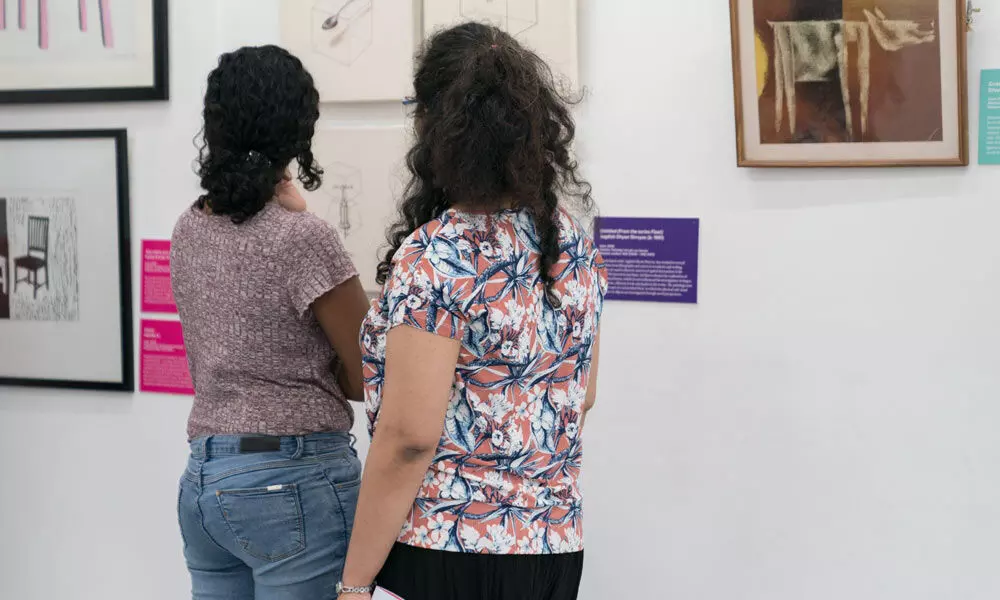Live
- Study tour for TG legislators soon
- State cabinet expansion by Dec 31: Ponguleti
- 2 Narayanites bag gold medals in IJSO-2024
- Jail superintendent suspended in ailing farmer handcuff incident
- CM Revanth orders probe into farmer’s handcuff incident
- Handcuffing of farmer after heart stroke draws BRS’ ire
- Jagga Reddy questions unilateral decisions of AICC in-charges in TG
- Tribal women to get trained in multiple skills
- GHMC vet officials raid mutton, chicken shops
- Rising egg prices set to turn Xmas cakes dearer
Just In
68% of people more inclined to go outdoors for activities in 2021: Survey


Participants at Championing Learning With the Arts, a MAP workshop for educators, 2020
The Museum of Art & Photography (MAP) released a survey to determine the audience behaviour in India's cultural sector.
Bengaluru: The Museum of Art & Photography (MAP) released a survey to determine the audience behaviour in India's cultural sector. The survey was conducted on 500 people, including school and college students, professionals across sectors, homemakers and senior citizens. in this nationwide survey, inputs flowed in from multiple states with 304 people giving their inputs from Karnataka.
"The study is part of MAP's ongoing initiatives to create a museum-going culture in India and help the cultural sector (museums in particular) engage their audiences better. Our vision at MAP is to take art to the heart of the community, and listening to our audiences' gives us valuable insights into what their values and expectations are, and how they can most benefit from the cultural activity." said Kamini Sawhney, Director, Museum of Art & Photography (MAP).
As per the study, most respondents thought arts and culture are essential but were unable to make time. Young people under 30 felt that Indian museums could present more engaging. 60.6 per cent of them said that Indian museums were not experimental enough. The study also discovered that while most people were excited about music shows as an outdoor activity, people preferred heritage tours and stage plays more than going for film screenings, book launches, traditional cultural events and religious cultural events. More than 300 people showed paintings as their preferred art medium, followed by contemporary art, photography and popular art and lastly followed by sculptures. Contradictory to expectations, schools students also showed a significant interest in getting creatively engaged and showed an interest in heritage and history. But the science and math-focused students were found less versed with cultures and held an outdated idea of a museum or a cultural site.
Despite the interest, people are also not very keen on spending too much money on sites that promote arts and culture. Nearly 72 per cent of the people responded that they did not these cultural engagements to be too heavy on the wallet. But, 54.5 per cent said that even though they think arts are important, they hardly manage to make time for it.
The impediment linked to a vibrant cultural space could also be due to the wrongful assumptions about them. 60.69 per cent felt that museums only cater to expert crowds and felt detached from their communities and the majority felt that they are boring and do not experiment with the overall experience enough.
Speaking about how cultural sites museums can adapt to the atmosphere, Kamini Sawhney said "We believe digital platforms and technology can profoundly impact the way arts and culture are experienced. Museums have a variety of opportunities they can tap to take their programmes to larger audiences online. At MAP, our engagement with technology is integral to our work - whether it is bringing together leading Indian and global museums together through our Museums Without Borders programme, or unique experiences such as the Artificial Intelligence project built around the persona of the famed Indian artist, M F Husain. As museums, we need to constantly adapt, and find innovative ways to engage with new technology and themes which are relevant to audiences."
Although the study states that people are more optimistic about going outdoors, numbers for the cultural havens in Bengaluru are only seeing a gradual increase. " After being completely shut down in 2020, we are opened only in October this year. People have started coming to the museum slowly. We have not opened completely, we hope to reach 98 per cent display by month-end", said Subarna Patro, Curator at National Gallery of Modern Art.
"Footfalls fluctuate depending on the type of show. If it is a show with regular viewership, we see a good crowd. Despite operating at 100 per cent seating capacity, we get booked quickly. It's not pre-Covid levels yet but it's slowly reaching there. We have also seen a considerable effort by the audience to adapt to the new atmosphere" said Trishala Srinivas, Program Assistant at Ranga Shankara.

© 2024 Hyderabad Media House Limited/The Hans India. All rights reserved. Powered by hocalwire.com






